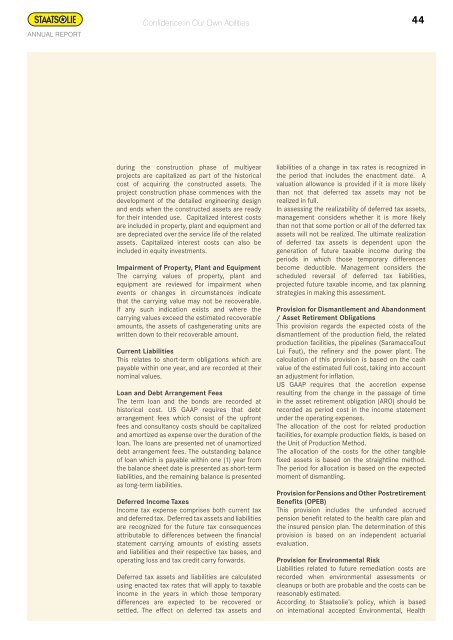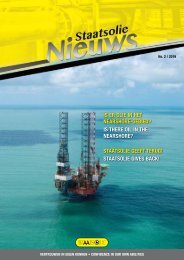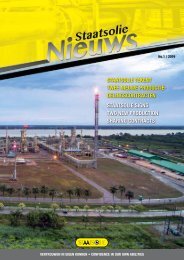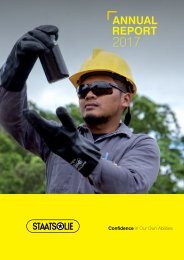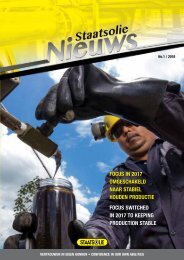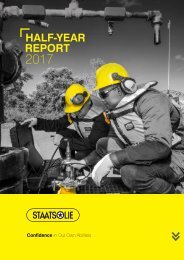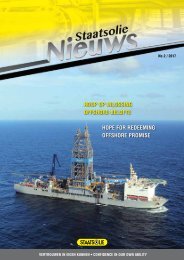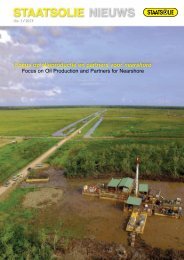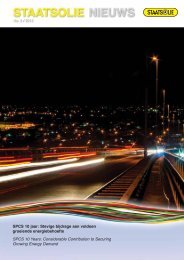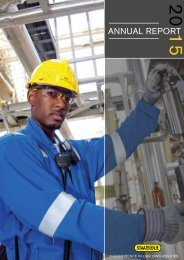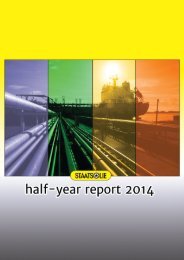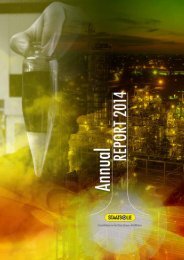annual_repport_staatsolie_2016_lr
You also want an ePaper? Increase the reach of your titles
YUMPU automatically turns print PDFs into web optimized ePapers that Google loves.
Annual REPORT<br />
Confidence in Our Own Abilities<br />
44<br />
during the construction phase of multiyear<br />
projects are capitalized as part of the historical<br />
cost of acquiring the constructed assets. The<br />
project construction phase commences with the<br />
development of the detailed engineering design<br />
and ends when the constructed assets are ready<br />
for their intended use. Capitalized interest costs<br />
are included in property, plant and equipment and<br />
are depreciated over the service life of the related<br />
assets. Capitalized interest costs can also be<br />
included in equity investments.<br />
Impairment of Property, Plant and Equipment<br />
The carrying values of property, plant and<br />
equipment are reviewed for impairment when<br />
events or changes in circumstances indicate<br />
that the carrying value may not be recoverable.<br />
If any such indication exists and where the<br />
carrying values exceed the estimated recoverable<br />
amounts, the assets of cashgenerating units are<br />
written down to their recoverable amount.<br />
Current Liabilities<br />
This relates to short‐term obligations which are<br />
payable within one year, and are recorded at their<br />
nominal values.<br />
Loan and Debt Arrangement Fees<br />
The term loan and the bonds are recorded at<br />
historical cost. US GAAP requires that debt<br />
arrangement fees which consist of the upfront<br />
fees and consultancy costs should be capitalized<br />
and amortized as expense over the duration of the<br />
loan. The loans are presented net of unamortized<br />
debt arrangement fees. The outstanding balance<br />
of loan which is payable within one (1) year from<br />
the balance sheet date is presented as short‐term<br />
liabilities, and the remaining balance is presented<br />
as long‐term liabilities.<br />
Deferred Income Taxes<br />
Income tax expense comprises both current tax<br />
and deferred tax. Deferred tax assets and liabilities<br />
are recognized for the future tax consequences<br />
attributable to differences between the financial<br />
statement carrying amounts of existing assets<br />
and liabilities and their respective tax bases, and<br />
operating loss and tax credit carry forwards.<br />
Deferred tax assets and liabilities are calculated<br />
using enacted tax rates that will apply to taxable<br />
income in the years in which those temporary<br />
differences are expected to be recovered or<br />
settled. The effect on deferred tax assets and<br />
liabilities of a change in tax rates is recognized in<br />
the period that includes the enactment date. A<br />
valuation allowance is provided if it is more likely<br />
than not that deferred tax assets may not be<br />
realized in full.<br />
In assessing the realizability of deferred tax assets,<br />
management considers whether it is more likely<br />
than not that some portion or all of the deferred tax<br />
assets will not be realized. The ultimate realization<br />
of deferred tax assets is dependent upon the<br />
generation of future taxable income during the<br />
periods in which those temporary differences<br />
become deductible. Management considers the<br />
scheduled reversal of deferred tax liabilities,<br />
projected future taxable income, and tax planning<br />
strategies in making this assessment.<br />
Provision for Dismantlement and Abandonment<br />
/ Asset Retirement Obligations<br />
This provision regards the expected costs of the<br />
dismantlement of the production field, the related<br />
production facilities, the pipelines (SaramaccaTout<br />
Lui Faut), the refinery and the power plant. The<br />
calculation of this provision is based on the cash<br />
value of the estimated full cost, taking into account<br />
an adjustment for inflation.<br />
US GAAP requires that the accretion expense<br />
resulting from the change in the passage of time<br />
in the asset retirement obligation (ARO) should be<br />
recorded as period cost in the income statement<br />
under the operating expenses.<br />
The allocation of the cost for related production<br />
facilities, for example production fields, is based on<br />
the Unit of Production Method.<br />
The allocation of the costs for the other tangible<br />
fixed assets is based on the straightline method.<br />
The period for allocation is based on the expected<br />
moment of dismantling.<br />
Provision for Pensions and Other Postretirement<br />
Benefits (OPEB)<br />
This provision includes the unfunded accrued<br />
pension benefit related to the health care plan and<br />
the insured pension plan. The determination of this<br />
provision is based on an independent actuarial<br />
evaluation.<br />
Provision for Environmental Risk<br />
Liabilities related to future remediation costs are<br />
recorded when environmental assessments or<br />
cleanups or both are probable and the costs can be<br />
reasonably estimated.<br />
According to Staatsolie’s policy, which is based<br />
on international accepted Environmental, Health


